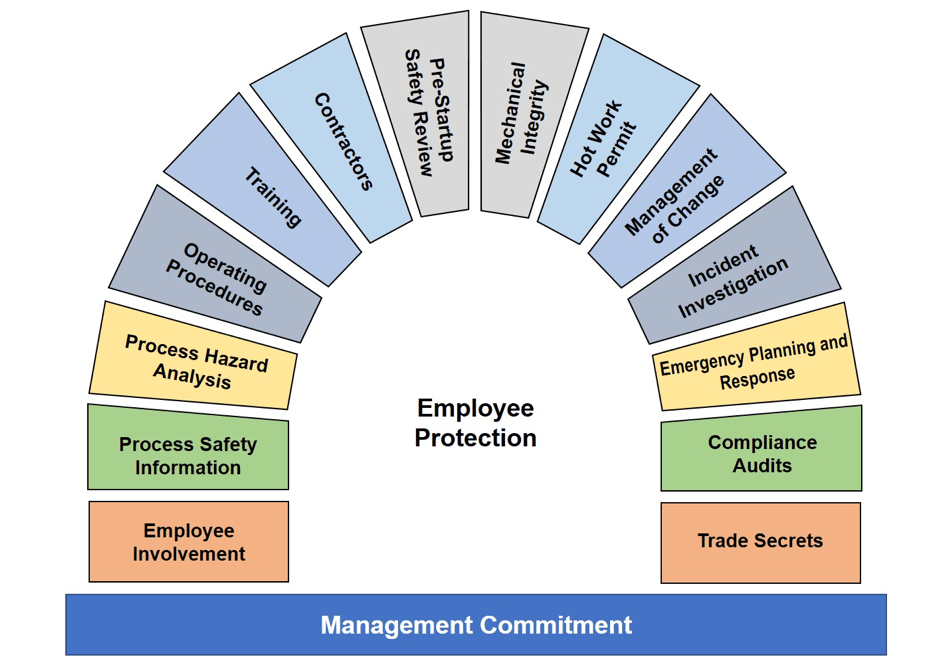Top 10 Best Practices for Effective Process Safety Management

Introduction: The Importance of Process Safety Management
Process Safety Management (PSM) is a critical approach used to prevent hazardous incidents in industries that handle chemicals, gases, and other high-risk materials. Proper implementation of PSM ensures workplace safety, environmental protection, and regulatory compliance.
Organizations that follow best practices in PSM can significantly reduce risks associated with chemical releases, fire hazards, and equipment failures. This article outlines ten essential best practices that help maintain an effective and compliant PSM framework.
1. Conducting a Comprehensive Hazop Study
A Hazard and Operability Study (HAZOP) is a structured methodology for identifying potential risks in industrial processes. It helps organizations assess deviation scenarios, equipment failures, and process inefficiencies before they escalate into safety hazards.
Key Steps in a HAZOP Study:
✔ Define the process and operational intent.
✔ Identify potential deviations and failure points.
✔ Assess the consequences and likelihood of hazards.
✔ Develop risk mitigation strategies based on findings.
A well-executed Hazop Study ensures early detection of process-related risks, reducing the chances of catastrophic failures.
2. Implementing a Strong Safety Audit Program
A Safety Audit is essential to assess an organization’s compliance with safety standards and regulations. It helps identify gaps in safety procedures, equipment maintenance, and emergency preparedness.
Best Practices for Safety Audits:
✔ Conduct regular audits to evaluate workplace safety measures.
✔ Establish an audit checklist covering equipment, training, and procedures.
✔ Ensure compliance with OSHA, ISO, and local safety regulations.
✔ Implement corrective actions for identified safety gaps.
Organizations can enhance safety by conducting a detailed Safety Audit and addressing any non-compliance issues proactively.
3. Strengthening Fire Safety Measures Through a Fire Audit
Industrial environments are prone to fire hazards due to flammable substances, electrical failures, and human errors. A Fire Audit helps organizations evaluate fire prevention, detection, and emergency response systems.
Core Components of a Fire Audit:
✔ Inspect fire suppression systems and extinguishers.
✔ Verify compliance with fire safety codes and building regulations.
✔ Assess fire drill effectiveness and employee preparedness.
✔ Identify and mitigate ignition sources in high-risk areas.
Regular Fire Audits minimize fire risks and improve emergency response efficiency.
4. Developing a Robust Process Safety Information (PSI) System
Maintaining accurate Process Safety Information (PSI) is essential for identifying hazards related to chemicals, equipment, and procedures. PSI serves as the foundation for all other PSM elements.
Best Practices for PSI Management:
✔ Document detailed information on chemical properties and hazards.
✔ Maintain up-to-date piping and instrumentation diagrams (P&ID).
✔ Keep records of safety data sheets (SDS) and operational limits.
✔ Ensure accessibility of PSI to all safety personnel.
Comprehensive PSI ensures employees are well-informed about workplace hazards and equipped to handle emergency situations.
5. Enhancing Employee Training and Competency Programs
A well-trained workforce is the first line of defense against industrial accidents. Regular training sessions improve employee awareness and emergency response skills.
Effective Training Strategies for PSM:
✔ Conduct hazard awareness and emergency response training.
✔ Implement hands-on simulation drills for critical situations.
✔ Provide periodic refreshers on safety policies and compliance requirements.
✔ Ensure training is tailored for specific job roles and responsibilities.
Regular training enhances employee preparedness, making workplaces safer and more resilient.
6. Establishing a Systematic Process Hazard Analysis (PHA)
Process Hazard Analysis (PHA) is a proactive approach to identifying and mitigating potential process hazards.
Key Aspects of PHA Implementation:
✔ Use HAZOP, FMEA, or What-If Analysis to assess risks.
✔ Evaluate worst-case scenarios and implement safeguards.
✔ Review PHA findings periodically to adapt to process changes.
✔ Involve cross-functional teams for diverse perspectives.
A strong PHA framework ensures early detection of operational risks, preventing major industrial incidents.
7. Enforcing Strict Mechanical Integrity Protocols
Equipment failures are a major cause of industrial accidents. Implementing a mechanical integrity program ensures that all critical machinery and systems remain in optimal working condition.
Best Practices for Mechanical Integrity:
✔ Schedule routine inspections and predictive maintenance.
✔ Maintain detailed records of equipment performance and repairs.
✔ Use non-destructive testing (NDT) for identifying structural weaknesses.
✔ Train operators on safe handling of critical equipment.
Proactive equipment maintenance reduces downtime, enhances safety, and ensures regulatory compliance.
8. Establishing a Permit-to-Work (PTW) System
A Permit-to-Work (PTW) system controls hazardous activities by ensuring necessary safety precautions before high-risk tasks are performed.
Essential Elements of an Effective PTW System:
✔ Require formal authorization before conducting hazardous operations.
✔ Specify hazard control measures in work permits.
✔ Conduct pre-job risk assessments before issuing permits.
✔ Monitor compliance and review PTW documentation regularly.
Implementing a PTW system reduces workplace accidents and improves safety compliance.
9. Creating an Emergency Response and Incident Investigation Plan
Preparedness for emergency situations is crucial for minimizing damage and ensuring quick recovery.
Best Practices for Emergency Preparedness:
✔ Develop site-specific emergency response plans.
✔ Conduct regular emergency drills for different scenarios.
✔ Train employees on first aid, fire response, and chemical spill containment.
✔ Establish a system for incident reporting and root cause analysis.
An effective emergency response plan ensures quick action during industrial accidents.
10. Engaging a Professional Safety Consultant for PSM Implementation
Process Safety Management is a complex discipline that requires expert oversight. Organizations can benefit from engaging an experienced Safety Consultant to evaluate and improve their PSM programs.
Benefits of Working with a Safety Consultant:
✔ Expert assessment of workplace hazards and compliance gaps.
✔ Customized safety solutions tailored to specific industry needs.
✔ Training programs for employees on best safety practices.
✔ Implementation of global safety standards in operations.
A trusted Safety Consultant can provide valuable insights to enhance process safety and risk management.
Conclusion: Strengthening Workplace Safety with Best PSM Practices
Implementing effective Process Safety Management practices is essential for ensuring workplace safety, regulatory compliance, and operational efficiency. Organizations that follow structured risk assessments, mechanical integrity programs, emergency response plans, and continuous training can prevent catastrophic failures and protect employees.
By incorporating these ten best practices, industries can create a safe and compliant work environment that minimizes operational hazards and ensures sustained business continuity.







